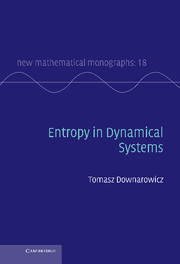Book contents
- Frontmatter
- Contents
- Preface
- Introduction
- PART I Entropy in ergodic theory
- 1 Shannon information and entropy
- 2 Dynamical entropy of a process
- 3 Entropy theorems in processes
- 4 Kolmogorov–Sinai Entropy
- 5 The Ergodic Law of Series*
- PART II Entropy in topological dynamics
- PART III Entropy theory for operators
- Appendix A Toolbox
- Appendix B Conditional S–M–B
- List of symbols
- References
- Index
5 - The Ergodic Law of Series*
from PART I - Entropy in ergodic theory
Published online by Cambridge University Press: 07 October 2011
- Frontmatter
- Contents
- Preface
- Introduction
- PART I Entropy in ergodic theory
- 1 Shannon information and entropy
- 2 Dynamical entropy of a process
- 3 Entropy theorems in processes
- 4 Kolmogorov–Sinai Entropy
- 5 The Ergodic Law of Series*
- PART II Entropy in topological dynamics
- PART III Entropy theory for operators
- Appendix A Toolbox
- Appendix B Conditional S–M–B
- List of symbols
- References
- Index
Summary
In this chapter we describe a relatively new result – a consequence of positive dynamical entropy of a process. It concerns the behavior of the return time random variables Rn(x) for large n, the same as treated by the Ornstein–Weiss Return Times Theorem, but in a complementary manner. The theorem has a very interesting interpretation, easy to articulate in a language accessible also to nonspecialists. Yet, as usual on such occasions, one has to be very cautious and not get enticed into pushing the conclusions too far. We begin this chapter with a short historical note concerning the debate on the Law of Series in the colloquial meaning. We explain how the Ergodic Law of Series contributes to this debate. Then we pass to the mathematical proof preceded by introducing a number of ergodic-theoretic tools.
History of the Law of Series
In the colloquial language, a “series” happens when a random event, usually extremely rare, is observed surprisingly often throughout a period of time. Even two repetitions, one shortly after another, are often interpreted as a “series.” The Law of Series is the belief that such series happen more often than they should by “pure chance” (whatever that means). This belief is usually associated with another; that there exists some unexplained force or rule behind this “law.” A number of idioms, such as “run of good luck” or “run of misfortune,” or proverbs like “misfortune never comes alone,” exist in nearly all languages, which confirms that people have been noticing this kind of mystery for a long time.
Information
- Type
- Chapter
- Information
- Entropy in Dynamical Systems , pp. 132 - 156Publisher: Cambridge University PressPrint publication year: 2011
